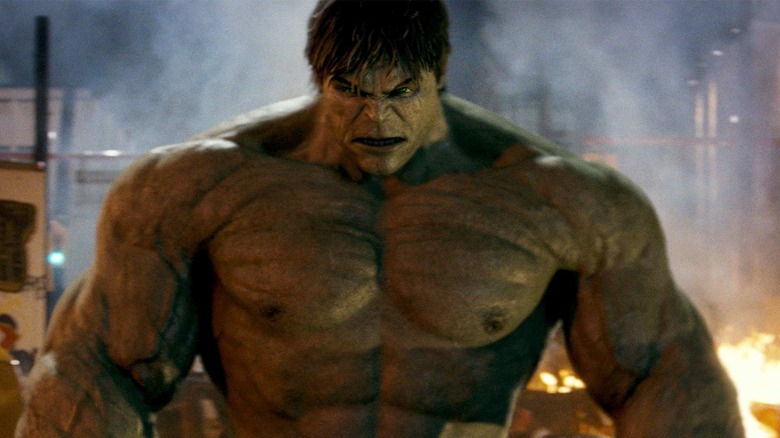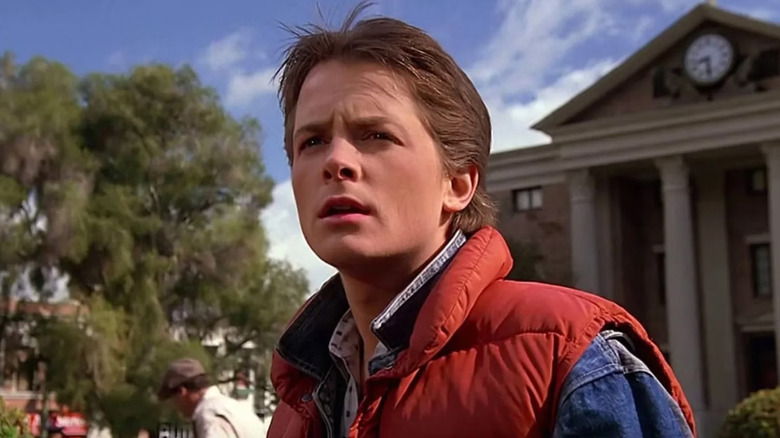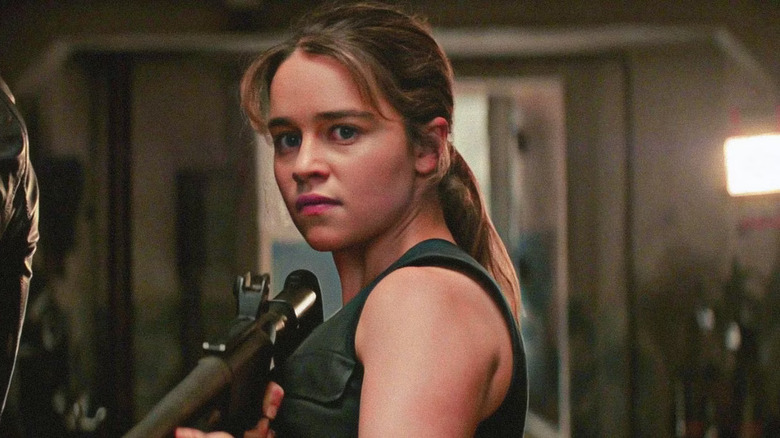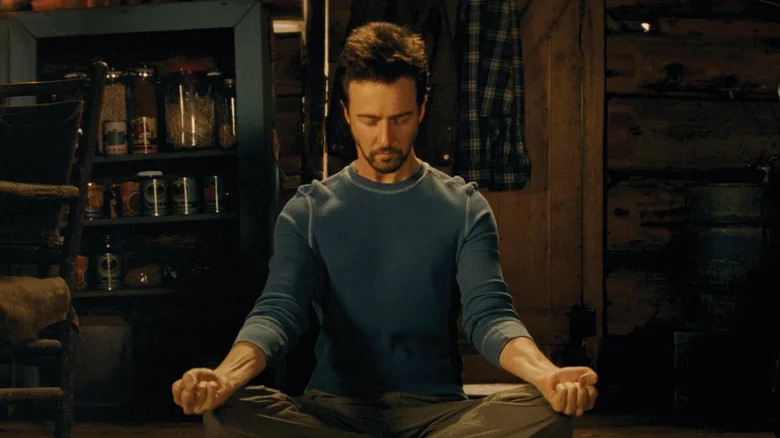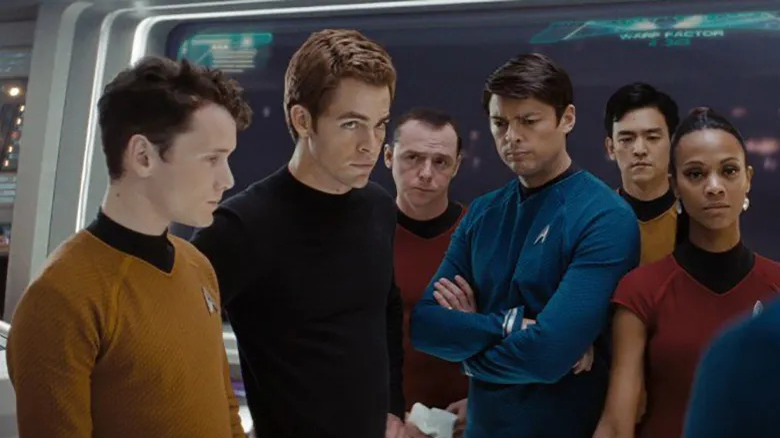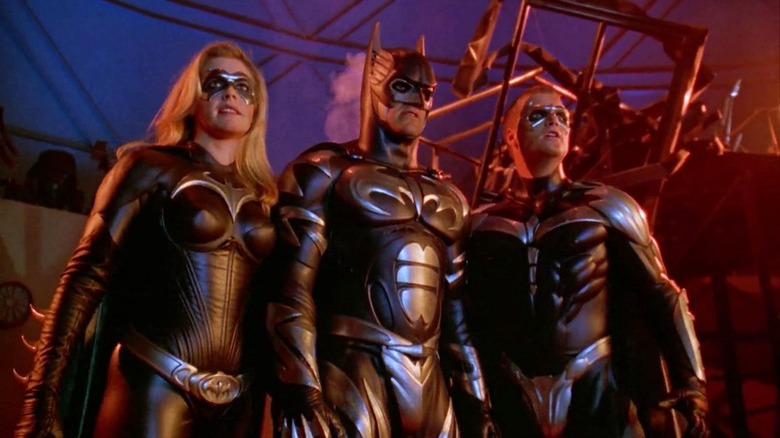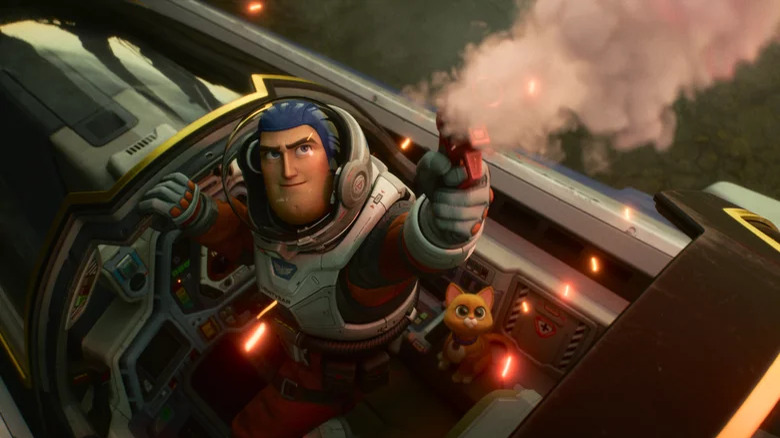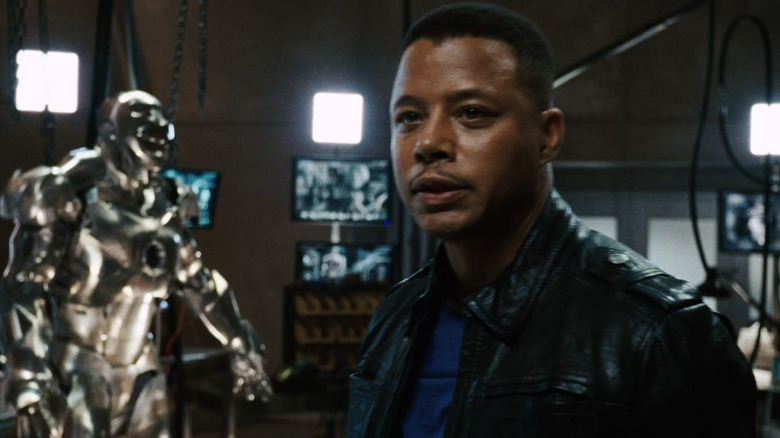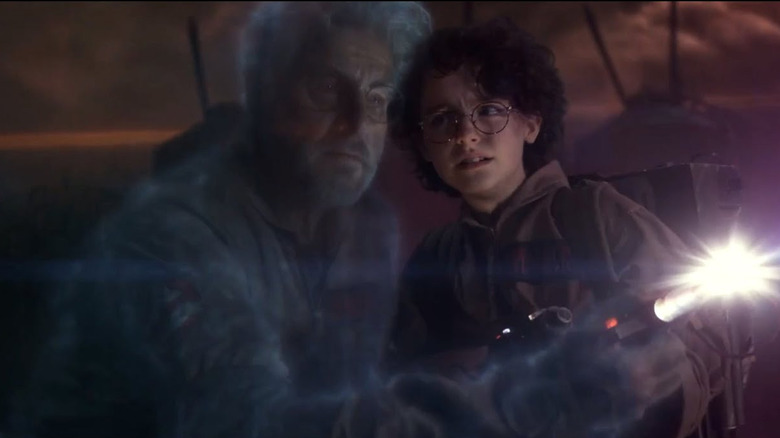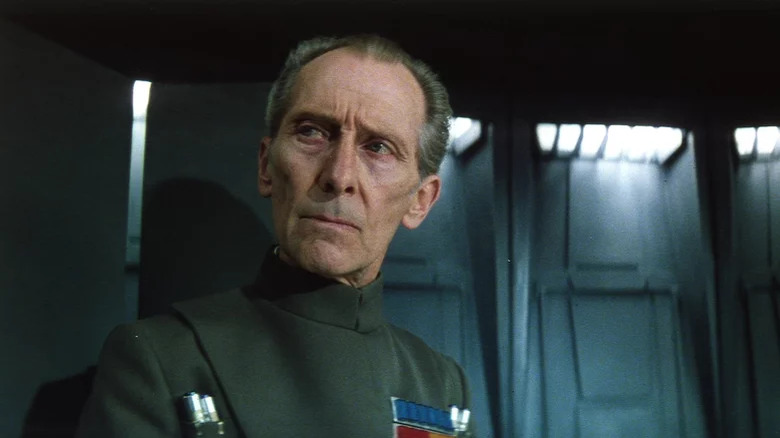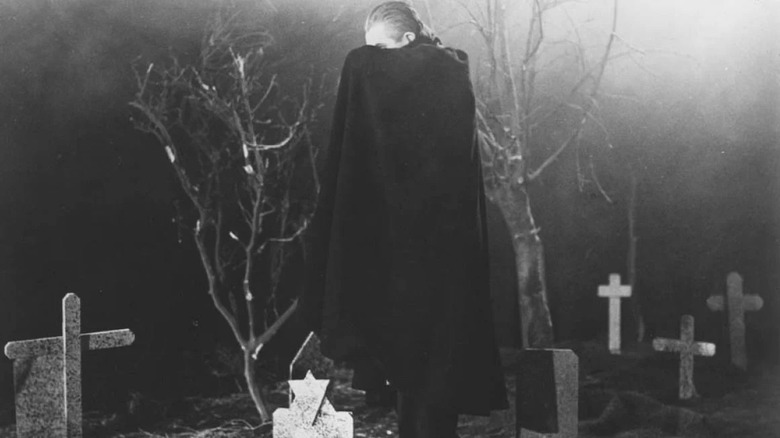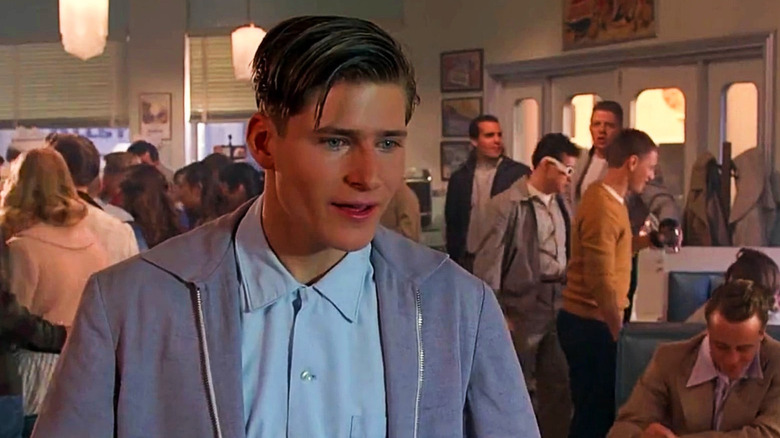The 11 Most Controversial Sci-Fi Movie Recastings
Not every actor is a Samuel L. Jackson, gladly signing an extensive superhero movie contract to play Nick Fury as many times as Marvel Studios wants him. Some are more like James Bond actor George Lazenby, securing an iconic part and then instantly worrying it'll cause typecasting. Meanwhile, some stars can't get along with the studio, while others, unfortunately, die before the role has run its course. No property or individual movie is immune to the possibility of recasting. It's just that some do it a lot better than others.
In the sci-fi realm, long-running franchises often pose unique casting challenges, but others are simply so difficult or so weird that they necessitated unexpected changes. The multiverse offers more recasting possibilities than most, as "Doctor Who" and its endless regenerations — a sci-fi solution to a real-world problem — regularly demonstrates. How the fans, the actors, and the studio react cannot always be predicted, which can stir up some controversy and debate.
Below, we list the 11 sci-fi recastings that caused divided reactions, hurt feelings, or just general complications. Ironically, they both begin and end with the same property, though given its lurches through chronology, perhaps that's most appropriate.
11. Marty McFly, Back to the Future
Most everyone agrees that Michael J. Fox is perfectly cast as teenager Marty McFly in "Back to the Future," and director Robert Zemeckis always had him in mind as the first choice. There was just one problem: "Family Ties" producer Gary David Goldberg didn't give him the script, concerned that Fox would have to leave the show if he got the part. Instead, in his place, Zemeckis cast Eric Stoltz.
A much more serious, method actor than Fox, Stoltz insisted on staying in character and tried to actually provoke his costars rather than cooperatively acting with them. Zemeckis and his producers, watching the dailies, were not happy with what they saw, and he had fellow filmmaker and producer Steven Spielberg give Goldberg a call again. This time, Fox got the script and agreed, but filming continued until he was available. Stoltz shot for over a month before he was fired by Zemeckis. (Read all about the long road to replacing Eric Stoltz with Michael J. Fox over here.)
Fox, at the height of production, managed to pull double-duty on "Family Ties" and "Back to the Future," and it made him a huge comedy star, though it took a toll on him personally, as recounted in his own documentary. Stoltz, befitting his more serious nature, continued his career in indies like "Pulp Fiction," "Killing Zoe," and "Mr. Jealousy," fitting more seamlessly into their darker, quirkier worlds.
Technically, Eric Stoltz is still in "Back to the Future," if you look really carefully.
10. Sarah Connor, Terminator: Genisys
Before Disney+ and TV spinoffs maintaining the same universe as the feature film whence they came, recasting was common. Robert Hays replaced Jeff Bridges for the "Starman" TV show, and Lena Headey replaced Linda Hamilton for "Terminator: The Sarah Connor Chronicles." Audiences roll with stuff like that, and it worked out just fine for "M*A*S*H."
Movies were another story. Time jumps arguably excused the recasting of John Connor from Edward Furlong in "Terminator 2" to Nick Stahl and Christian Bale in subsequent sequels. "Terminator: Genisys," however, gave us Emilia Clarke and Jai Courtney playing Sarah Connor and Kyle Reese (respectively) at the same ages they were supposed to be in the original "Terminator." Leniency might have been given with a complete cinematic recast, but there was still Arnold Schwarzenegger, both as an older Terminator and his younger self via digital face transplant, as revealed in an extensive VFX breakdown.
Reese had been recast in the prior movie, "Salvation," with Anton Yelchin, so Courtney, as unlikely as he looked, at least felt more like the tough commando type. Yet despite coming off of playing a tyrannical Daenerys Targaryen, Clarke was no Linda Hamilton. She was so not Linda Hamilton, in fact, that the next movie wiped the chronology slate clean, specifically so it could bring back Hamilton in the role.
Had the "Genisys" storyline continued, Matt Smith's character was supposed to go full-multiverse, before that was cool, and the series could potentially have brought back Hamilton and Headey. We'll never know.
9. Bruce Banner, The Avengers
It's not easy being green. Eric Bana's tenure as Bruce Banner, the scientist cursed to become the superhuman Hulk when he gets angry, didn't last past Ang Lee's introspective-yet-visually-comic-booky first film. When "Iron Man" looked to give Marvel a fresh start at a unified universe, Edward Norton was cast in the role, ostensibly to be a more comics-accurate Banner.
Perhaps pushing his luck, and not truly understanding what the Marvel Cinematic Universe could be yet, Norton insisted on heavily rewriting Zak Penn's script. He even went as far as saying he wrote the movie, despite the Writer's Guild ruling to credit Penn only. Norton and the producers feuded over final run-time during post-production, and when Mark Ruffalo was cast as Banner in "The Avengers," Kevin Feige made a statement that he better embodied the spirit of cooperation. For his part, Norton said he didn't want to be typecast.
The recasting worked out for Marvel and for audiences, and it even sparked a new rule for Marvel Studios casting from then on. Norton's "Incredible Hulk" rated nearly the same as Ang Lee's "Hulk" on Rotten Tomatoes (67% versus 63%), while Ruffalo, who gave Banner and Hulk more of a sense of humor, subsequently became one of the most popular elements in the "Avengers" movies, as well as "Thor: Ragnarok."
"The Incredible Hulk" contributed to the perception that Norton could be difficult and a perfectionist, but he has continued to work steadily, in part because director and regular collaborator Wes Anderson remains someone with whom he has no issues.
8. The Entire Enterprise Bridge Crew, Star Trek (2009)
"Star Trek" used to be as sacred as sci-fi nerd properties got. It was the show that inspired conventions in the first place, cared deeply about its lore, and knew that the fans knew every time they made an error in chronology or fictional future-science. As a movie franchise, however, it was spotty, with a general consensus being that only the even-numbered installments were good. After two duds in "Insurrection" and "Nemesis," it clearly wasn't working anymore on the big screen, and it needed a makeover.
Fans and filmmakers had mulled over the notion of a Starfleet Academy film for years, but a reboot that recast everyone with younger actors could have been blasphemous. William Shatner, Leonard Nimoy, et al., were fully associated in the public sphere with their "Trek" personae; in turn, they put a lot of their own personalities into those characters they originated. To cast that aside could potentially alienate the entire existing fan base.
The way they made it work was by bringing it to Nimoy and refusing to make the movie without him. Having Nimoy's Spock enter a changed past allowed for the original "Trek" timeline to still exist, while the new one would be a parallel dimension. This was also helpful with the then-split between Paramount and CBS; the former could keep the new movie timeline, while the latter could still work within the TV timeline.
Spock and Kirk have subsequently been recast yet again for TV.
7. Bruce Wayne, Batman & Robin
The "Batman" franchise set a precedent for recasting its lead when Tim Burton was nudged out and Michael Keaton went with him. Follow-up director Joel Schumacher chose Val Kilmer to succeed him, in a choice that seemed to answer all the early fan criticisms of Keaton – Kilmer was tall, muscular, conventionally handsome, and had a distant stare that made his Bruce Wayne look distracted by darker thoughts. "Batman Forever" was praised at the time for getting the franchise back on track after "Batman Returns" veered heavily into German Expressionist horror, but Schumacher hated working with Kilmer, whom he found difficult. When scheduling conflicts made Kilmer unavailable for the next one, Schumacher said it felt like a huge favor.
George Clooney, whom Schumacher had liked in "From Dusk Till Dawn," stepped in, and while he proved easier to work with, his Batman and the film surrounding him played like a colossal joke. Thanks to a studio mainly interested in toy sales, a script full of bad puns and campy humor, not to mention Schumacher relying on his young nephew's description of the TV animated series, and Clooney's nipply costume, "Batman and Robin" became the epitome of everything wrong with superhero movies. Clooney has repeatedly apologized for his part in the film, and only last year, proved that the idea of him as Batman still played like a punchline (and was used as one) at the end of 'The Flash."
6. Buzz Lightyear, Lightyear
Pixar wouldn't be Pixar without the "Toy Story" films, which went from proving fully CG-animated films could work to ushering in their dominance as the primary medium for cartoon films in the modern age. What helped immensely in the beginning was that the first film paired two of Hollywood's biggest stars together for the first time: two-time Best Actor winner Tom Hanks, and iconic sitcom dad Tim Allen, who had just made a hugely successful leap to the big screen with "The Santa Clause." Hanks and Allen were Woody and Buzz, a talking cowboy doll and the spaceman action figure threatening his place in playtime. For a TV cartoon spinoff, Patrick Warburton voiced Lightyear, but in four films, it was always Allen — until one day it wasn't.
"Lightyear," loosely a spin-off of the "Toy Story" franchise, depicted Buzz as a "real" human. The idea behind it was a serious older sci-fi movie that had been young Andy's favorite film, so much so that he had to have the toy based on it. For that to work, the movie needed to be more of a serious take on the character than a toy with an identity crisis, and Chris Evans was cast as the new Buzz Lightyear. Who better for an all-American astronaut than Captain America?
The fans didn't get it, nor did Allen, with some commentators suggesting Disney had fired him for his conservative politics. The "Santa Clause" TV spinoff and his imminent return to "Toy Story 5" say otherwise, but that doesn't change how underwhelming "Lightyear" turned out to be.
5. War Machine, Iron Man 2
"Next time, baby!" When Col. James Rhodes (Terrence Howard) looked at the silver suit in "Iron Man," all comic fans knew what he meant. If a sequel happened, he would have suited up as War Machine. Eventually, James Rhodes did suit up, but it wasn't Terrence Howard in the role. Into the sequel walked Don Cheadle, saying, "It's me, I'm here, deal with it, let's move on." He delivered the line to Tony Stark, but it might as well have been to the audience. The change caused a years-long feud between Terrence Howard and Robert Downey, Jr., with Howard claiming he vouched for Downey on the first movie, but when it came time to talk about the sequel, Downey didn't return the favor.
So why was Terrence Howard replaced as War Machine in the MCU? It's complicated. It also depends on whom you ask, but the issue seems to have been a combination of money and personality clashes. Downey was lowballed on the first film because his past substance abuse issues still made him an insurance risk, and Howard was paid significantly more. For the sequel, Marvel wanted to properly reward Downey, so they asked Howard to take a pay cut in order to compensate the superhero lead. Director Jon Favreau reportedly didn't get along with Howard, and they had to reshoot a lot of his material, so some say Marvel deliberately lowballed Howard to get rid of him.
With his ex-wife's charges of abuse and Marvel's recent dismissal of Jonathan Majors, he might not have lasted regardless.
4. Egon Spengler, Ghostbusters: Afterlife
One of the biggest obstacles to making a third canonical "Ghostbusters" movie was the death of Harold Ramis in 2014. Though he wasn't at the same level of stardom as Bill Murray or Dan Aykroyd, his Egon Spengler was essentially the leader of the Ghostbusters, especially so in the TV cartoon version. Plus, he was one of the key writers of the original franchise. "Afterlife" acknowledged the actor's death by having the character die too — but then they brought him back from the dead as a CG ghost with body doubles used for his death scene (actor Bob Gunton and "Ghostbusters" director Ivan Reitman served as stand-ins).
In the movie, it's a touching moment to see Egon as a ghost reuniting with the granddaughter he never knew. In real life, however, it remains a questionable choice to show a character dying after the actor has actually died — and creating a "performance" from archival and enhanced imagery that we can never know for certain would meet with the deceased star's approval.
It's especially uncomfortable, perhaps, to have an action figure of the ghost of the dead performer.
3. Grand Moff Tarkin, Rogue One: A Star Wars Story
Grand Moff Tarkin, the other primary villain in the original "Star Wars" besides Darth Vader, had been played by famous and beloved character actor Peter Cushing. The classic horror actor died in 1994, which wasn't immediately an issue for the galaxy that Lucasfilm built. In fact, when the prequel trilogy called for him to appear briefly at the end of "Episode III," Wayne Pygram played a younger version with prosthetics.
Then, following Disney's acquisition of Lucasfilm, plans for more movies began to include spin-offs and inter-quels — the first one to get greenlit was "Rogue One," a story following the theft of the Death Star plans. Canonically, the Death Star was Tarkin's pet project, so how could the character best be re-included? Lucasfilm could have gone the way they did with "Solo: A Star Wars Story," which cast Alden Ehrenreich as young Han Solo and Donald Glover as young Lando Calrissian. Instead, "Rogue One" took a big swing by bringing Grand Moff Tarkin back to the big screen via CGI, creating what was effectively a digital Peter Cushing mask for actor Guy Henry. While the result looked like Cushing, it also clearly looked and emoted like a digital effect.
Ironically, Henry already looked a lot like Cushing. Had he simply been recast with basic prosthetics, viewers would probably have accepted it as easily as they did when Emperor Palpatine was recast between "Empire Strikes Back" and "Return of the Jedi." Instead, a trend was set for "Star Wars" to recast with digital trickery.
2. The Old Man, Plan 9 From Outer Space
Looking to gain the notoriety of directing Bela Lugosi's final film, director Edward D. Wood Jr. used footage from a scrapped project with the deceased actor to begin his sci-fi/horror hybrid, "Plan 9 From Outer Space." He'd written himself into a conundrum, however, as Lugosi's character, simply named "The Old Man," gets resurrected later in the script by aliens to become a ghoul. Beset by time and budgetary constraints that remain obvious even for the time, Wood cast his wife's chiropractor, Tom Mason, in the additional scenes.
The problem was Mason was not only obviously taller than Lugosi, but he also looked nothing like him, problems Wood remedied by having Mason crouch low and hold a cape over his face.
Had that been the film's only setback, perhaps it would have languished into obscurity. But along with the fragile, wobbly sets with poor props, along with spray-painted model kits used as flying saucers, a zombie-like performance by wrestler Tor Johnson even before his character is resurrected as a zombie, gratuitous stock footage, and overall hilarious overacting combined to make the film a cult classic of "bad" movies. Michael and Harry Medved, in their book "The Golden Turkey Awards," dubbed it the worst movie of all time, paradoxically bringing it all-new attention and notoriety. Mason never intended to be an actor, but he became one whose dual performances — he made one more film for Wood, "Night of the Ghouls" — live in cinematic infamy.
1. George McFly, Back to the Future Part II
Crispin Glover's performance as George McFly in "Back to the Future" was arguably a star-making performance, more than holding his own against TV sitcom veterans Michael J. Fox and Christopher Lloyd in terms of quotable lines and memorable moments. Was it enough to merit a similar paycheck to Fox's for the sequel, though? Universal didn't think so — Fox remained a popular fixture on TV's "Family Ties," while Glover followed the movie up with "River's Edge" and "At Close Range.
According to producer Bob Gale, on the DVD extras, Glover asked for the same amount of money as Fox, but Glover has denied this, saying he was offered less than half of what Thomas F. Wilson and Lea Thompson were given. "Back to the Future" left Glover and Gale's relationship in shambles, and Glover felt that questioning what he saw as a pro-corporate message in the film turned the filmmakers against him.
Glover was replaced by Jeffrey Weissman — using makeup molds cast from Glover's face in the first film to change his appearance — and some repurposed footage of Glover from the first film. The legal drama you didn't see behind the scenes involved Glover suing over the unauthorized use of his likeness, which settled for $760,000. He has claimed since that the Screen Actor's Guild changed their rules as a result, making it harder for anyone to do anything of the kind again, but SAG declines to comment on such things.
